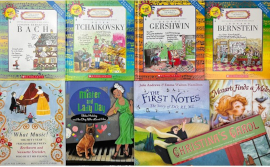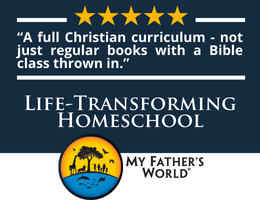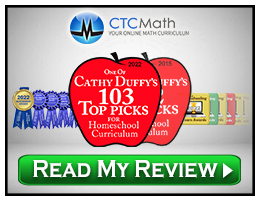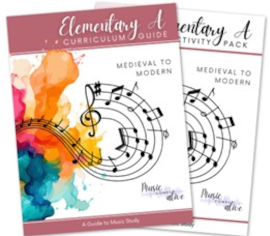The Music Comes Alive literature-based, music appreciation curriculum is available for two levels, primary (grades K-2) and elementary (grades 3-5). I received the elementary level for review, so that is my main focus. The course was designed for parents to teach at home but can be used in group settings.
Through this course, students begin to learn how to read music, they learn about some instruments and their sounds, and they become familiar with great composers and their works. The instruction on music fundamentals is at an introductory level and requires no previous knowledge, and the music-making activities are doable for families with no musical training.
Course Components
The course uses two course books (titled Elementary A Curriculum Guide and Elementary A Activity Pack), nine picture books, a musical playlist, and online resources. The course books are available in print or as PDFs. (The Activity Pack pages can be printed or copied for your household, and licenses are available for reproducing pages for a class.) The picture books can be purchased as a package, but you might find the books at your library.
 The nine picture books used are:
The nine picture books used are:
- The First Notes: The Story of DO, RE, MI, by Julie Andrews and Emma Walton Hamilton
- Johann Sebastian Bach, Revised Edition, by Mike Venezia
- Mozart Finds a Melody, by Stephen Costanza
- Christina's Carol: Featuring the Classic Poem "In the Bleak Midwinter" by Christina Rossetti, illustrated by Tomie dePaola
- What Music!: The Fifty-Year Friendship between Beethoven and Nannette Streicher, Who Built His Pianos, by Laurie Lawlor
- Peter Tchaikovsky, Revised Edition, by Mike Venezia
- George Gershwin, Revised Edition, by Mike Venezia
- Mister and Lady Day: Billie Holiday and the Dog Who Loved Her, by Amy Novesky
- Leonard Bernstein, Revised Edition, by Mike Venezia
How It Works
The course should take eight and a half months—essentially one school year—to complete. It is arranged in eight units that each take four weeks to complete, plus a two-week Christmas unit. This schedule relies on completing one lesson per week in a session that takes less than an hour, although optional viewing and listening might take longer. Each of the nine units centers around the story of one musician and information about one musical instrument, while also teaching one aspect of music fundamentals and providing one interactive activity. For instance, the third unit has students read the book about Mozart, learn about treble clef spaces, study the clarinet, and make a straw flute. Other activities support these primary learning strategies, including optional books to read.
For each unit, the Activity Pack has a page for students to enter information about the unit’s composer or musician, one worksheet on the fundamentals, one page on the featured instrument, a few Listening Pages (for students to draw or color in response to music), and, sometimes, one or more pages to be used in an activity. The minimal amount of written work should be manageable for most students in grades three through five.
Suggested answers to comprehension/discussion questions are included within the lesson plans, and information to be filled in on activity pages can easily be checked with information in the Curriculum Guide.
Digital resources are linked through QR codes within the lesson plans and accessed through a password-protected page—access does not expire. (You can also access the page using the URL near the front of the Curriculum Guide.) The digital resources (mostly videos) present musical performances, biographies of composers, music theory, information about instruments, and activity instructions.
Playlists for either YouTube® or Spotify® have four links per unit (two for the Christmas unit) to musical performances. Instructions on the Listening activity pages say, “Color or draw the mood, story or picture(s) you hear.” Parents should also use the guiding questions from the lesson plans to highlight elements of the various musical pieces.
The fourth week of each unit (and the second week of the Christmas unit) is for a hands-on project, game, or other interaction, plus a listening assignment. The interactive activity for each unit might be an art project or music-making, or you might use resources from the Activity Pack book to play musical charades or solve musical riddles.
The Curriculum Guide has a Month-at-a-Glance page for each unit with check-off boxes and space for notes. Following that page are weekly lesson plans that provide background information parents can read to children in an open-and-go fashion, comprehension and discussion questions for the picture books, instructional information on music fundamentals to present to students, suggestions for guiding listening activities, supply lists, and directions for projects. Lesson plans also show exactly when to use pages from the Activity Pack, digital resources, or the playlist. The lesson plans sometimes have students review or recite information about the music fundamentals they’ve learned, so there’s some built-in review.
Primary Level
The Primary level follows the same format, using a different set of picture books and simplified activities that require very minimal writing.
Summary
Music Comes Alive does a great job as an introduction to music appreciation, and children are likely to enjoy the picture books, listening to music, watching videos, and participating in other activities.








